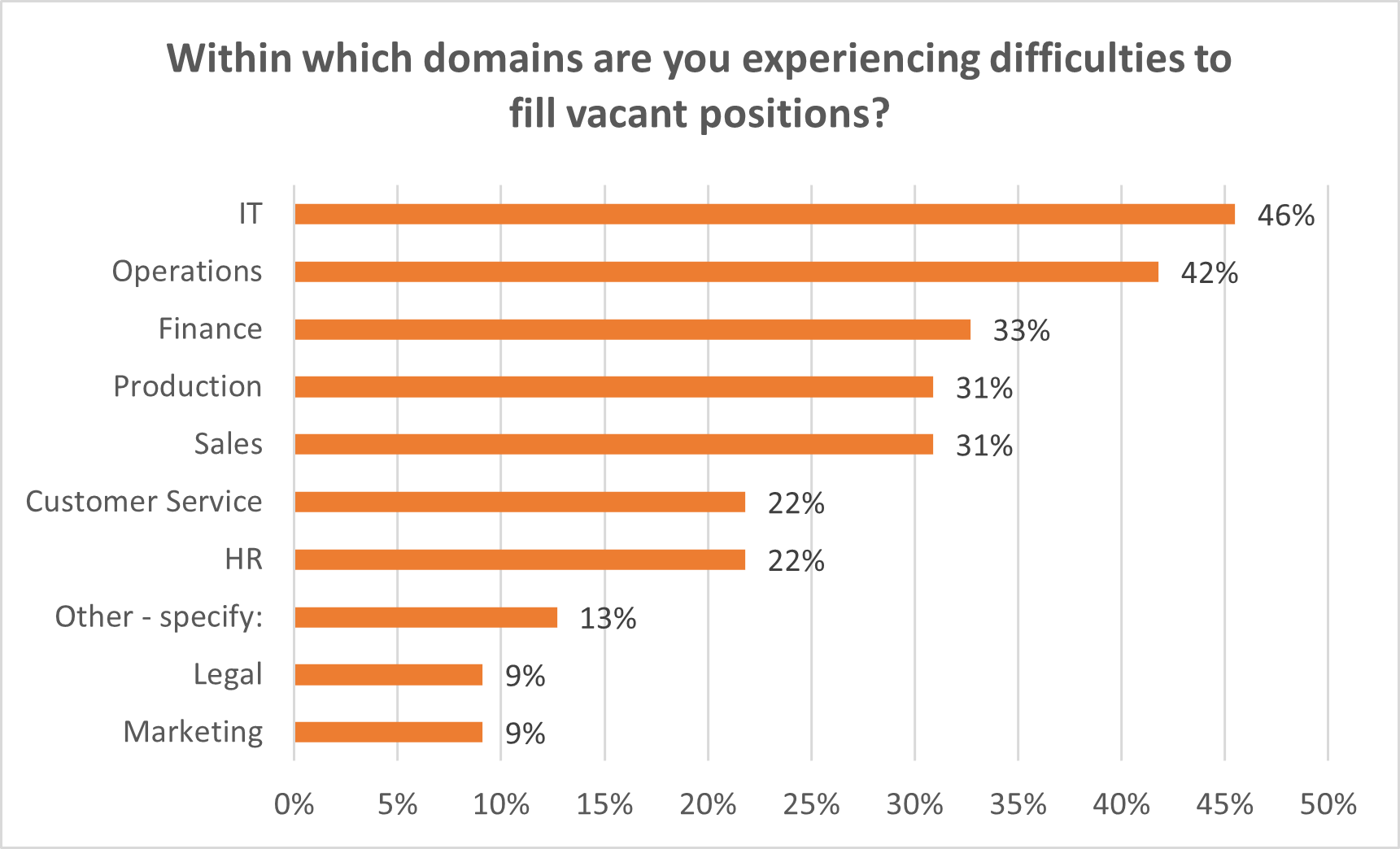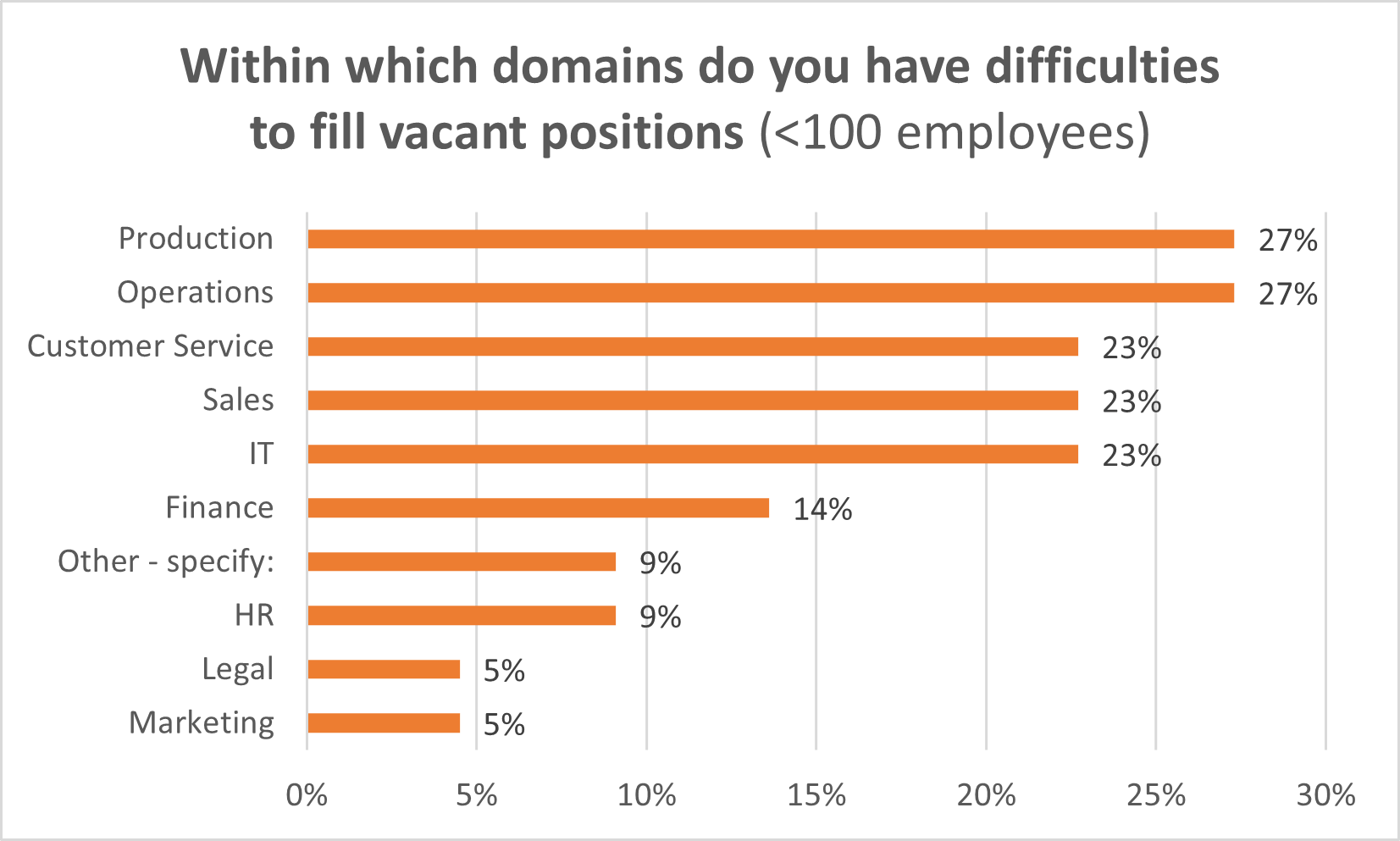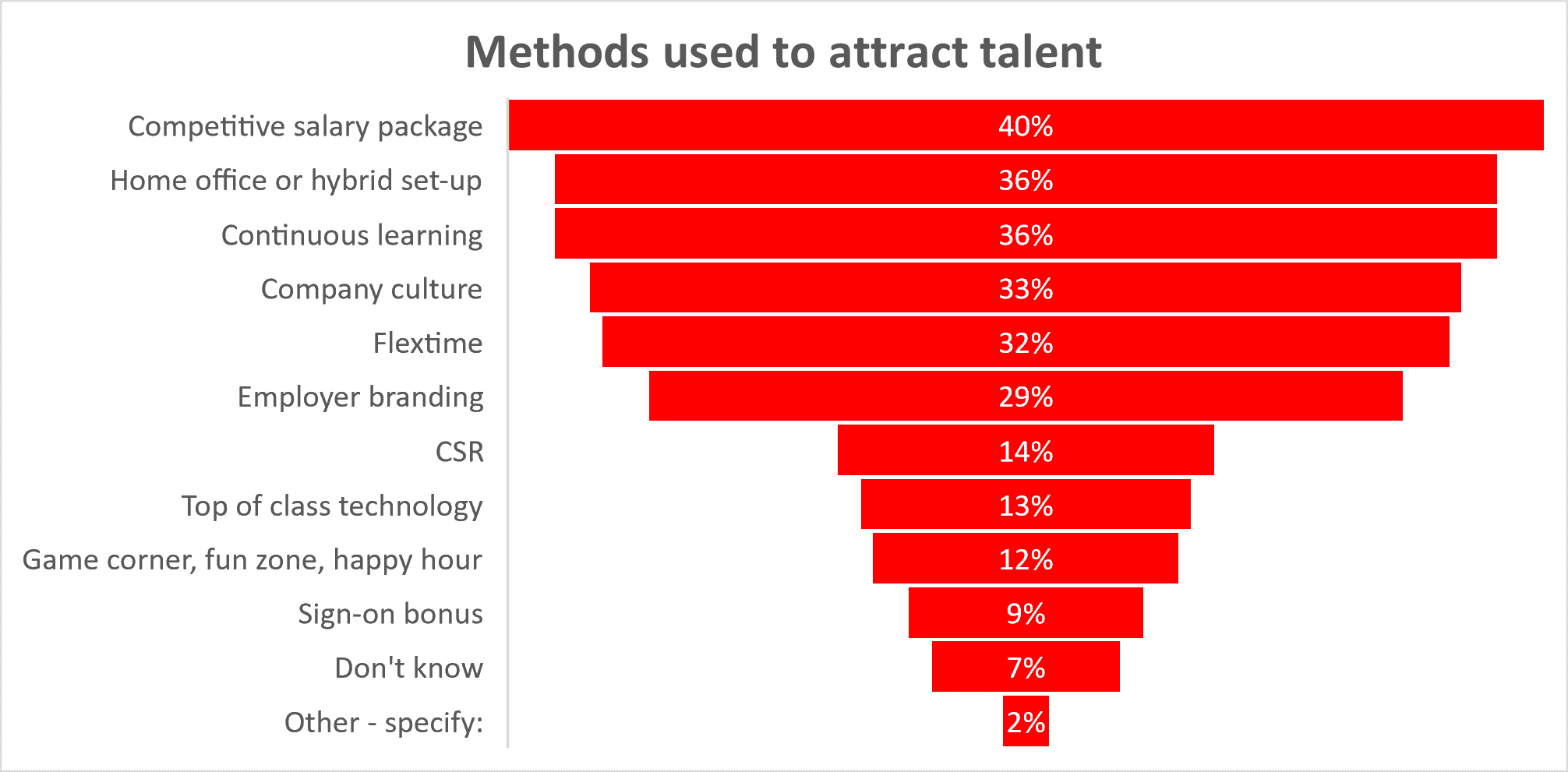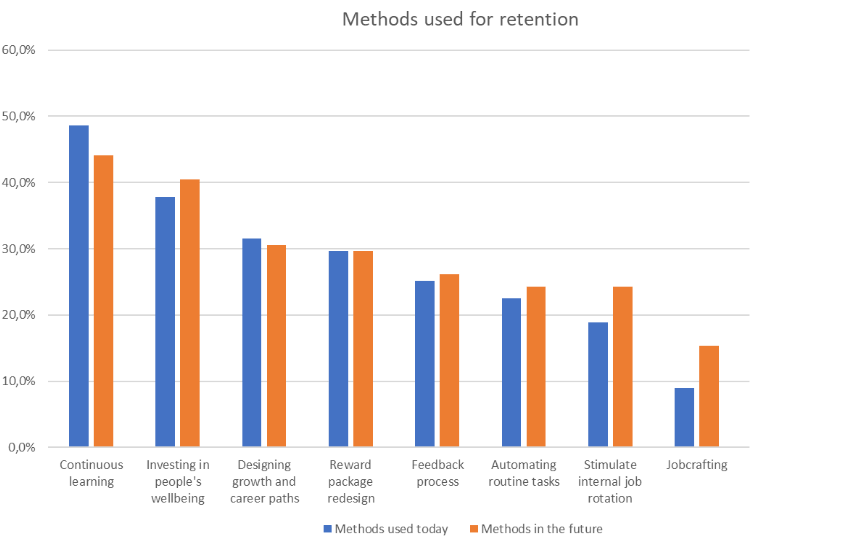Addressing the Talent Crunch
28 October 2022FOCUS ON THE FUTURE OF YOUR BUSINESS 2:
Belgian Executives and Talent Shortage
In June 2022, TriFinance, TriHD, and TriTechnology surveyed more than 100 executives to understand their approach to the talent crunch and the transformations in their organizations. We also investigated to what extent sustainability is impacting the growth of their business.
When asked which risks will have the greatest impact on their company, talent shortage came out on top. One in two C-level executives flagged the talent crunch as the main risk. That’s especially true for executives of large corporations. SMEs with less than 100 employees, however, mentioned economic crises, disruption of supply chains, and inflation as major risks.

The Talent Crunch mainly hits IT, Operations and Finance
Most companies that have difficulties filling vacant positions are struggling to find professionals for IT , Operations, Finance, Sales, and Production.
Larger companies (> 1000 employees) especially struggle to fill IT (8 out of 10) and Finance positions (7 out of 10). When we broaden the scope to companies employing over 100 people, still 6 out of 10 experience hardship hiring IT talent, and 5 out of 10 struggle to fill Finance positions.
Companies that have their decision centers abroad also face difficulties hiring people in Sales and Marketing positions. Overall, it is hard for them to hire people in IT and Sales and Operations.
‘The larger the company,’ CFO Services Client Partner Filip Ceulemans says, ‘the more difficult it becomes to attract skilled talent. We notice that multinational companies struggle in multiple functional domains to hire people as they more often need a larger number of high-skilled professionals to support and develop their more often complex services and products.’
7 out of 10 companies in manufacturing say it is hard to fill vacancies in Operations.
SMEs (<100 employees) seem to have fewer problems filling positions. One in four SME respondents mentioned that it is difficult to hire people for Production jobs and Operations. One in five has a hard time hiring Customer Service, Sales, and IT people.

Attracting talent during the Talent Crunch
Research among Belgian professionals with a bachelor's or master's degree shows the most important requirement for them to start working for an organization is an attractive comp & ben package, followed by continuous learning and career development. Another requirement for professionals to even consider working for an organization is flexibility. Rather than companies with rigid work arrangements, professionals prefer hybrid working environments, autonomy, and place and time independent working hours.
Reward as a dissatisfaction remover
From their side, organizations are aware that these requirements must be met to attract skilled people. Their top-3 solutions actually match candidate requirements. The top answer being a competitive salary package still proves that a solid reward package is a condition sine qua non. Even in times of soaring inflation and challenging wage indexations. Reward was and is a dissatisfaction remover. If the reward package does not feel right, candidates will not even consider working for your company.

‘An abundant organization enables its employees to be completely fulfilled by finding meaning and purpose from their work experience,’
Dave Ulrich, 'The Why of Work'
Looking for a purpose: the abundant organization
Among the methods to attract talent, no one solution sticks out. The six most popular solutions all score between 29 and 40 percent, suggesting companies will use a combination of most of them.
To attract the best talents, companies today offer different employee value propositions veering toward an employee experience that no other company can offer.
People don't choose an employer just to earn money. An organization is also a place to learn, share knowledge, work, and develop their talents and career. But as Dave and Wendy Ullrich explain in The Why of Work, an organization is also a place where people find meaning and purpose. ‘People find meaning when they see a clear connection between what they highly value and what they spend time doing,’ Dave Ullrich says.
They will, in particular, find meaning and purpose in what he calls ‘abundant organizations’. ‘An abundant organization enables its employees to be completely fulfilled by finding meaning and purpose from their work experience,’ Ullrich says. ‘This meaning enables employees to have personal hope for the future and create value for customers and investors. When we ask people how they feel about their work, we can quickly get a sense of how work helps them fulfill the things that matter most in their lives.’
Sustainability and the corporate agenda
That might explain one of the most remarkable findings of the TriFinance survey: it showed a clear correlation between the maturity level of a company in the field of sustainability (CSR, ESG) and the difficulty of filling vacant positions. Organizations that put sustainability high on the corporate agenda find it easier to attract the right people.
That finding contrasts sharply with the fact that only 14 percent of participating executives use CSR to attract talent. Clearly a working point for the future, although the use of social responsibility and sustainability in recruitment campaigns is not obvious.
Jonas Muylaert, Talent acquisition lead at TriFinance: ‘Randstad Employer Branding research confirmed this trend. Job seekers tend to be attracted by CSR initiatives. Sustainability means that companies take up their responsibilities. This is an attractive employee value proposition. The 3 Ps of sustainability for companies are People, Profit, and Planet. Companies putting their employees and the planet first while not forgetting value creation for their shareholders are considered to be more attractive in the labor market.’
Could sustainability be a new method for attracting talent? Jonas Muylaert says companies should be careful about (mis)using sustainability in their employer branding. It could compromise the authenticity of their sustainability approach, ending up being counter-productive.

Retaining talent
Next to finding new talent, one of the biggest challenges for organizations is retaining talent. Our C-level respondents don’t see huge differences when it comes to retention methods now and in the near future. Continuous learning and well-being remain the most important pillars (4 in 10 respondents), followed by designing growth & career paths and an attractive (total) reward package (3 in 10 respondents). Remarkable is the importance of the feedback process as a retention factor as well.
It seems that the most successful companies in terms of retention are the ones who can put all these pieces together, resulting in an integrated and personalized employee experience, authentic employee engagement and more internal job rotation, which is indicated as a retention factor that will become more important in the future.
Lifelong learning and the need for up and reskilling are where people and business needs go hand in hand.
Inge Arys, Talent Manager at TriFinance
Freelancers and consultants in the war for talent
How can we handle this talent shortage? How can we broaden our supply of talents? Or as Professor Peter Capelli stated: ‘should we build, buy or borrow talent?’. One in two of the executives responding to our survey saw one option standing out: engaging freelancers or consultants. One in three is also inclined to hire interim managers. One in four will add insourcing to that and have activities in house performed by external partners.
Large companies with their decision center abroad, in particular, tend towards hiring freelancers as they feel the pressure of the specialist talent shortage more strongly than local SMEs.
The rise of the contiguous workforce is happening right now. We are not talking about a marginal phenomenon anymore, but about a growing population that is extremely relevant and useful for organizations.
But what value does it bring to the table?
Hanne Hellemans, BU leader at TriFinance: ‘This result does not surprise me. A few years ago, most companies considered project sourcing and interim management a necessary evil but today a lot of them are incorporating project sourcing and interim managers into their strategic workforce planning. It's a way to make your organization more agile while benefiting from the unexpected insights and market knowledge these outside experts bring. And let’s not forget the financial benefits, like avoiding recruitment costs, training costs, the cost of a "wrong hire" and so on. Project sourcing offers the opportunity to attract expertise without bearing the risks and costs of a direct hire.”

Related content
-
Blog
How the technology of Microsoft Fabric can help you maximize the value of your data
-
Article
How Lakehouse technology can help solve your siloed data problem
-
Blog
EFRAG’s simplified ESRS: what it means and why sustainability reporting still matters
-
Blog
Webinar takeaways: How to deal with common challenges in your data projects
-
Article
Why CFOs can’t afford to ignore Data Engineering in 2025
-
Article
Power BI training: from data literacy and data modeling to strategic reporting in finance
-
Career as Consultant
Junior Finance Consultant | Public Sector
-
Career as Consultant
Medior Finance Consultant | Public Sector
-
Career as Consultant
Senior Finance consultant | Public sector
-
Career as Consultant
Junior Consultant Public Procurement | Public Sector
-
Career as Consultant
Medior Consultant Public Procurement | Public Sector
-
Career as Consultant
Senior Consultant Public Procurement | Public Sector